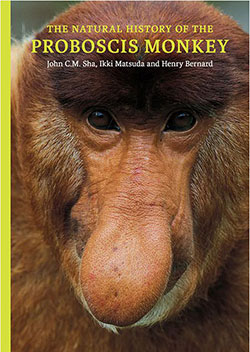The Natural History of the Proboscis Monkey
By John C.M. Sha, Ikki Matsuda & Henry Bernard – (2011)
 126 pages; matt art paper, with 101 colour photographs & 5 maps.
126 pages; matt art paper, with 101 colour photographs & 5 maps.
Soft Cover: 21.5cm x 15.2cm.
ISBN: 978-983-812-130-9
Natural History Publications (Borneo) Kota Kinabalu
The proboscis monkey is one of the most fascinating of the Asian primates and sadly like numerous other primates, also one of the most endangered. Although the authors point out there is still much we do not know about these unique monkeys, they (the authors) have still managed to expertly bring to our attention the latest developments and what the authors have discovered during their unique research.
This book covers many aspects of their natural history and conservation including climatic factors, forest types and their ethnic human inhabitants, behavioral patterns at a social and intimate level, social foraging, foraging ecology and the sharing of sleeping roosts with other species, anti-predatory tactics and other finer details and aspects of their life ecology as well as methods of field study and the benefits of ethically conducted eco tours and the impact of negative human activities.
What is important and significant about this book besides bringing to our attention the latest in research and raising our level of knowledge generally, is the fact this very unique species has been largely neglected as a conservation subject. By comparison, the orangutan which is also found in Borneo, has received very wide publicity globally in support of its endangered status. The plight of the proboscis is compounded by the fact, destruction of some their normal foraging habitat forces them to congregate along river banks and in mangroves etc. and as such they are the most easily observed primate in Borneo, so hence they appear to be abundant in numbers. They do not specialize in inhabiting just mangroves as previously thought. So the fact they are easily observed is misleading in assuming they are not under any serious threat, when in fact the opposite is certainly the case and primarily as a result of insensitive and predatory human activities!
Many nice photos are presented here and not all of the proboscis monkey either, other fauna include slow loris, salt water crocodile, spotted fruit bat, bearded pig and others. This is thoughtfully written and a nicely illustrated and highly informative book providing the most up to date data and account of these very interesting and sadly endangered primates and its place on the book shelves of all naturalists and any visitors to Borneo is a must!
Rod Rice
Principal Reviewer
Nature & Travel Books
